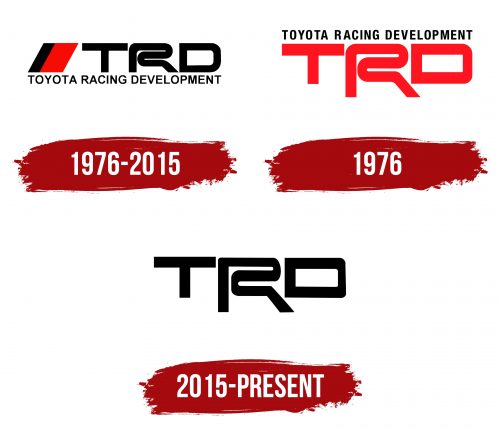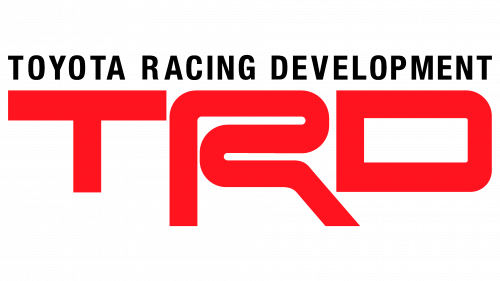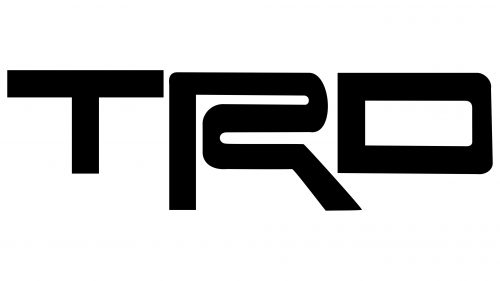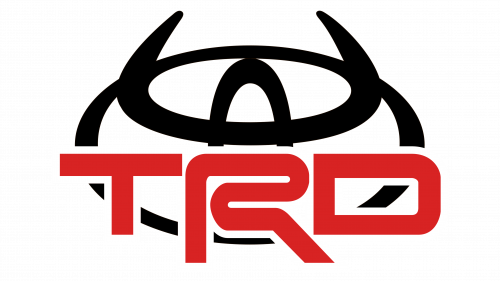The TRD logo demonstrates an unbreakable connection to racing. It represents the tuning division of one of the most renowned automakers in the world. The emblem reflects the capability of its vehicles to maneuver through the sharpest turns while maintaining steel-like composure effortlessly.
TRD: Brand overview
Toyota began its involvement in motorsports in the late 1950s when Toyota Racing Development (TRD) was founded. In 1957, Toyota competed in its inaugural “Around Australia Rally. “Due to this experience, the company’s motorsport branch saw considerable growth.
Toyota continued to participate strongly in racing competitions throughout the 1960s, which resulted in the department’s establishment as Toyota Sports Corner (TOSCO) in 1966. TOSCO created sporting components for customers’ automobiles and designed and assembled Toyota racing cars.
Toyota’s motorsport program saw significant development during the 1970s. The branch known as Toyota Racing Development was formally founded in 1976. The enterprise assumed control of TOSCO’s operations and broadened its purview to include developing high-performance parts for Toyota’s production vehicles and racing cars.
The motorsport division initially concentrated on competing in Japanese racing championships, including the Japanese Rally Championship and the All Japan Touring Car Championship. Thanks to the knowledge acquired in these competitions, the organization was able to develop and improve technologies that were eventually implemented into Toyota’s production cars.
The enterprise reached a major turning point in 1979 when it started manufacturing and marketing high-performance components for Toyota vehicles owned by customers. This made it possible for enthusiasts to use parts created from the division’s racing experience to improve the performance of their cars.
The organization increased its visibility on the global racing scene in the 1980s. Toyota started competing in the World Rally Championship (WRC), managing the development and preparation of rally cars through the motorsport branch. Stage victories and other WRC accomplishments helped the division establish a solid reputation as a major participant in the motorsport industry.
The motorsport arm continued to grow throughout the 1990s. The US division was founded in 1993 to create high-performance parts for the US market. This growth attracted new clients and helped the brand become more well-known outside Japan.
The organization aggressively competed in racing series throughout the 1990s and 2000s, including the 24 Hours of Le Mans, Super GT in Japan, and NASCAR in the United States. Thanks to its wide range of experiences, the brand amassed a wealth of information and advanced technology in several motorsport-related fields.
The product range for Toyota’s automobile production expanded in the 2000s. Extensive upgrade packages that included external design features and mechanical components were introduced for several models. As a result, a unique range of highly performance-tuned Toyota cars was produced.
Toyota’s comeback to Formula 1, the most prestigious racing series in the world, was made possible in large part by the motorsport division in 2007. This branch was responsible for engine development and production for the Toyota F1 team. Even though Toyota’s involvement in Formula 1 concluded in 2009, the knowledge and expertise acquired throughout this series greatly impacted the branch’s subsequent advancements.
In the 2010s, the range of production cars continued to expand, and the division entered racing series. The company created and manufactured high-performance parts for various Toyota vehicles, including trucks, SUVs, and compact automobiles.
The division continued to bolster its NASCAR standing in 2011 by supporting Toyota teams with new engines and aerodynamic packages. Particular attention was paid to optimizing the performance of V8 engines, which enhanced the series’ success in the Sprint Cup events.
The company experienced notable success in rally raids in 2013. The Toyota Hilux, prepared by the division, finished the Dakar Rally in second position overall, which at the time was Toyota’s best finish in this renowned sport.
In 2015, the organization expanded the scope of its production car tuning operations. A fresh range of Pro parts was unveiled for SUVs and pickups, encompassing upgraded suspensions, skid plates, and unique wheels.
2017 was a crucial year for the company in the endurance racing world. The renowned “24 Hours of Le Mans” race marked the first overall victory for the Toyota TS050 Hybrid, which the division helped design. This accomplishment was the culmination of years-long work to improve hybrid technologies in motorsports.
The division unveiled the Toyota Camry model, a new race vehicle for the NASCAR Cup Series, in 2019. With this model’s enhanced aerodynamics and more economical engine, Toyota teams were able to contend for the top spots in the championship.
In 2020, the company expanded into the electrification sector. To meet the changing needs of the motorsports industry, engineers started actively working on developing electric and hybrid powertrains for upcoming Toyota race cars.
In 2022, the organization introduced a new range of high-performance parts for Toyota GR (Gazoo Racing) production vehicles. These parts, including modified braking and suspension systems and aerodynamic components, were created using knowledge from the racing series.
In 2023, the division decided to concentrate on developing next-generation endurance racing technologies. The business showcased a concept hypercar for the FIA World Endurance Championship’s Le Mans Hypercar (LMH) class. This vehicle demonstrated the firm’s dedication to motorsport innovation by combining cutting-edge hybrid technologies with creative aerodynamic solutions while adhering to new regulations.
In 2024, the corporation greatly increased the scope of its production car program. The firm unveiled a new range of high-performance parts for Toyota’s electric vehicles, such as improved battery cooling systems, altered electric motors, and specifically made chassis. Applying the division’s experience to the expanding electric vehicle market was a step forward.
The business kept developing, utilizing its background in motorsports to enhance Toyota’s race and production cars and adjusting to emerging technical trends in the automotive sector.
Meaning and History
What is TRD?
It is Toyota’s in-house tuning, performance, and racing division. It specializes in designing and developing parts and accessories for Toyota vehicles, including engines, suspension systems, exhaust systems, brakes, and aerodynamic components. The company supports Toyota’s motorsports activities by providing expert support to racing teams in various competitions worldwide. In addition, it develops special models and performance packages such as TRD Pro, TRD Off-Road, and TRD Sport, which feature upgraded components and unique design elements to enhance performance and driving experience.
1976 – 2015
The TRD emblem from this period has a multi-component structure that includes the company’s short and full name and graphic symbol. Each element is placed separately, without touching one another, but together, they form a harmonious image in which every detail holds a distinct place.
The lower area features the phrase “Toyota Racing Development,” which also serves as a base for the abbreviation. To fit the long phrase within the compact size of the abbreviated name, the designers reduced its size by using a smaller font. The letters are straight and strictly vertical, without serifs, composed of clear, thin strokes. The glyphs appear slightly compressed from the top due to the massive abbreviation hovering above. However, there’s no feeling of cramped space, as the wide inner letter spacing ensures excellent legibility.
The top row contains the abbreviated form “TRD.” Unlike the lower text, it is large and resembles a hand-drawn element with custom graphic symbols. This is seen in the stylized “R,” which looks like a winding racetrack. In contrast, the neighboring letters are characterized by restraint, precision, and simplicity. They have no curves or rounded edges, designed in a geometric style with perfectly straight lines and sharp angles.
The combination of standard and unique glyphs conveys that the tuning center adheres to all technical regulations but incorporates creativity to achieve results that will delight clients. Supporting this idea, next to the abbreviation is the brand symbol—a parallelogram divided into two color sections:
- A narrow stripe is colored black;
- A wide band is rendered in vibrant red.
This combination conveys determination, focus, and drive, achieved through the contrasting palette. The upper projecting corner points to the right as if racing forward, infusing the emblem with energy and dynamic movement. Speed is the primary expression of the TRD logo. The bold uppercase letters signify the company’s high capabilities and ambitious plans for the future.
1976
The stylized “R” remains the central element of the logo. It has retained its curved shape, still resembling a racetrack with sharp turns. The tuning center aims to convey that vehicles upgraded by them can handle even the sharpest corners. Thus, the winding letter expresses the brand’s concept easily, subtly, and effectively.
The three large glyphs are in uppercase. They lack serifs but have ample spacing between them, ensuring excellent legibility. To enhance contrast and increase vibrancy, the abbreviation is rendered in red. This choice is more striking than standard black, as it draws attention and instills a sense of positivity in customers. Additionally, red symbolizes leadership, intensity, and peak emotions.
The full name has been moved from the second line to the first: it is no longer the base for the upper text but now serves as its symbolic “roof.” Under the careful supervision of Toyota Racing Development, vehicles gain a unique look and superior technical characteristics. The name is written in uppercase with perfectly straight letters. There are no serifs, ensuring readability from any distance. The bold glyphs give the text a solid and authoritative appearance.
The color scheme has undergone some changes. As observed, the red has become a few shades lighter, making scarlet the dominant color in the emblem. It is at the beginning of the color palette’s gradation, opening the spectrum of red shades. Scarlet symbolizes good fortune, resourcefulness, and vivid positive experiences, perfectly aligning with TRD’s brand ideology. It also represents the blood pumping through the arteries in sync with the “heart” of a race car.
2015 – today
With each iteration, the TRD logo becomes increasingly simplified. Only the short name remains this time, with an integrated racing track represented by the capital “R.” Now, the designers have brought it to the forefront, significantly increasing its size. At the same time, they made the lines slightly thinner and minimized the curve in the upper left corner.
The two adjacent letters have also been “slimmed down” a bit, making the top bar of the “T” appear excessively long and disproportionate to the vertical stroke. In contrast, the “D” looks balanced, resembling a car’s windshield. At the same time, it looks like a widened “O,” with the only difference being the two non-rounded corners on the left. This approach draws attention to the “racing track” symbol, emphasizing its significance.
As a result of the redesign, the thematic symbolism has a powerful visual impact on the target consumer segment. The numerous curves on the large glyph and its unique shape evoke the desired association with the drive to be the first to finish, heightened energy, a powerful surge, dynamism, and determination. The distinctive quirkiness of the “R” makes the logo highly recognizable and perfectly aligned with the brand’s concept.
The choice of color reinforces the idea of swift movement, precision, strictness, and technical compliance with standards. This time, black was chosen—a refined, practical, and versatile color that looks harmonious on any background. Paired with the bold abbreviation, it complements the technical theme perfectly. Interestingly, black comes across as innovative in this case—without any romance or intensity.








